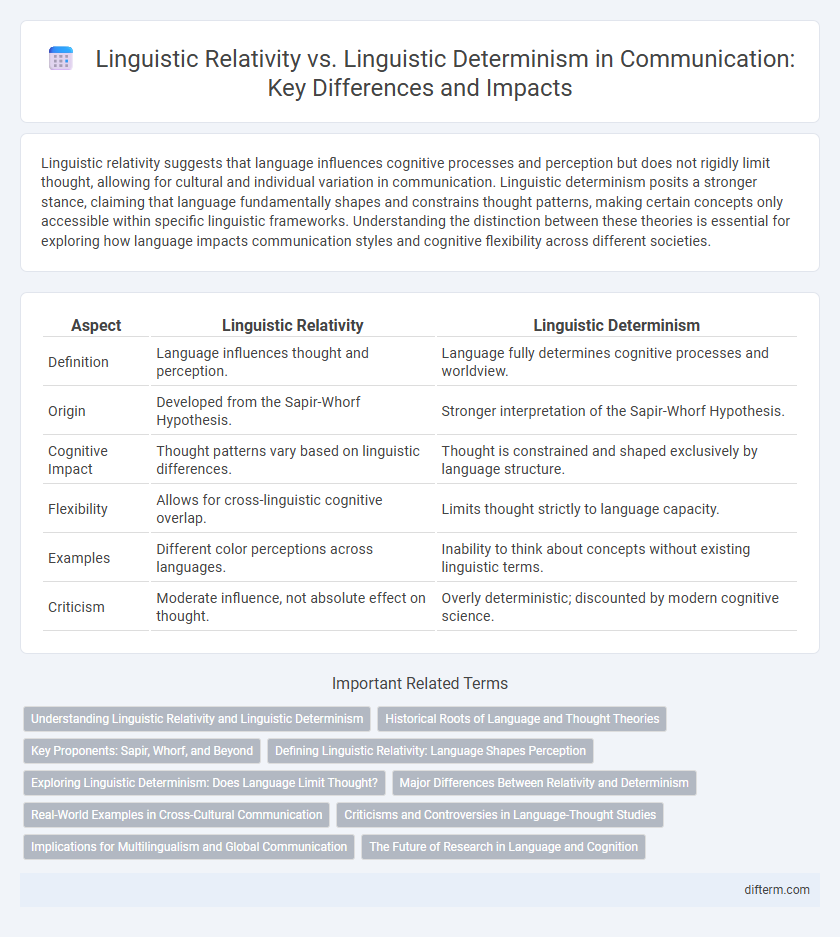Linguistic relativity suggests that language influences cognitive processes and perception but does not rigidly limit thought, allowing for cultural and individual variation in communication. Linguistic determinism posits a stronger stance, claiming that language fundamentally shapes and constrains thought patterns, making certain concepts only accessible within specific linguistic frameworks. Understanding the distinction between these theories is essential for exploring how language impacts communication styles and cognitive flexibility across different societies.
Table of Comparison
| Aspect | Linguistic Relativity | Linguistic Determinism |
|---|---|---|
| Definition | Language influences thought and perception. | Language fully determines cognitive processes and worldview. |
| Origin | Developed from the Sapir-Whorf Hypothesis. | Stronger interpretation of the Sapir-Whorf Hypothesis. |
| Cognitive Impact | Thought patterns vary based on linguistic differences. | Thought is constrained and shaped exclusively by language structure. |
| Flexibility | Allows for cross-linguistic cognitive overlap. | Limits thought strictly to language capacity. |
| Examples | Different color perceptions across languages. | Inability to think about concepts without existing linguistic terms. |
| Criticism | Moderate influence, not absolute effect on thought. | Overly deterministic; discounted by modern cognitive science. |
Understanding Linguistic Relativity and Linguistic Determinism
Linguistic relativity suggests that language influences thought and perception, shaping how individuals interpret their experiences without rigid constraints. Linguistic determinism posits a stronger stance, arguing that language confines cognitive processes and limits the scope of thought. Understanding these theories clarifies the dynamic relationship between language structure and cognitive function in communication studies.
Historical Roots of Language and Thought Theories
Linguistic relativity and linguistic determinism trace their historical roots to early 20th-century scholars such as Edward Sapir and Benjamin Lee Whorf, who explored the impact of language on cognitive processes. The Sapir-Whorf hypothesis posits that language influences thought patterns, with linguistic determinism representing the stronger claim that language confines and determines cognitive abilities. These foundational theories emerged from cross-cultural linguistic studies, highlighting how different languages shape distinct worldviews and cognitive frameworks.
Key Proponents: Sapir, Whorf, and Beyond
Edward Sapir and Benjamin Lee Whorf are seminal figures in linguistic relativity and determinism, emphasizing how language shapes thought processes and cultural perceptions. Sapir introduced the idea that language influences worldview, while Whorf advanced linguistic determinism, asserting that language limits cognitive abilities. Contemporary research extends their theories, exploring neural mechanisms and cross-cultural communication, highlighting the interplay between language, cognition, and social interaction.
Defining Linguistic Relativity: Language Shapes Perception
Linguistic relativity asserts that language influences how individuals perceive and interpret their experiences, shaping thought patterns without rigidly constraining cognition. It suggests that speakers of different languages attend to and prioritize various aspects of reality differently due to linguistic categories. Unlike linguistic determinism, which posits that language confines thought, linguistic relativity emphasizes a flexible but significant role of language in framing human perception.
Exploring Linguistic Determinism: Does Language Limit Thought?
Linguistic determinism posits that language fundamentally shapes and confines cognitive processes, suggesting that individuals can only think within the bounds of their linguistic categories. This theory contrasts with linguistic relativity, which argues that language influences but does not rigidly limit thought patterns. Research in cognitive science and cross-linguistic studies examines how language structures potentially constrain memory, perception, and problem-solving abilities.
Major Differences Between Relativity and Determinism
Linguistic relativity posits that language influences thought and perception, allowing cognitive flexibility across different linguistic frameworks. In contrast, linguistic determinism asserts that language strictly confines and determines the structure of thought, limiting cognitive possibilities to linguistic categories. The major difference lies in relativity's allowance for linguistic influence without absolute restriction, whereas determinism enforces linguistic boundaries as the definitive limits of human cognition.
Real-World Examples in Cross-Cultural Communication
Linguistic relativity, exemplified by how spatial orientation varies between English speakers who use egocentric directions and Australian Aboriginal communities using cardinal directions, influences cross-cultural communication by shaping cognitive processes and perception. In contrast, linguistic determinism, illustrated by the Inuit's multiple words for snow, suggests language limits thought but is less supported in practice, as bilingual individuals navigate multiple linguistic frameworks fluidly. Real-world examples like these demonstrate that while language influences communication styles and cultural understanding, it does not rigidly confine cognitive abilities across cultures.
Criticisms and Controversies in Language-Thought Studies
Criticisms of linguistic relativity often highlight its ambiguous empirical support and challenges in isolating language effects from cultural influences, while linguistic determinism is widely contested for its extreme claim that language entirely restricts cognition. Scholars debate the methodological validity of studies supporting both theories, emphasizing the difficulty in measuring subtle cognitive variations attributable solely to linguistic differences. Controversies persist over whether language shapes thought habits or rigidly confines mental processes, with recent research favoring a more nuanced interaction between language, cognition, and culture.
Implications for Multilingualism and Global Communication
Linguistic relativity emphasizes how language influences thought patterns, allowing multilingual individuals to navigate diverse cultural perspectives more flexibly in global communication. In contrast, linguistic determinism suggests language restricts cognitive abilities, potentially limiting cross-cultural understanding in multilingual contexts. Balancing these theories highlights the importance of linguistic diversity in enhancing effective communication across international boundaries.
The Future of Research in Language and Cognition
Emerging research in language and cognition increasingly explores the continuum between linguistic relativity and linguistic determinism, emphasizing how language shapes thought without rigidly limiting it. Advances in neuroimaging and cross-linguistic studies reveal nuanced interactions between language structures and cognitive processes, offering insights into bilingualism, conceptual framing, and cultural influences. Future investigations aim to integrate computational modeling and empirical data to clarify the dynamic role of language in shaping perception, memory, and reasoning across diverse populations.
linguistic relativity vs linguistic determinism Infographic

 difterm.com
difterm.com